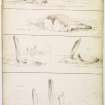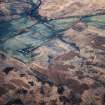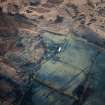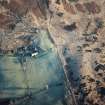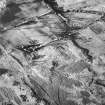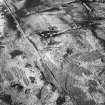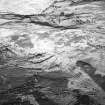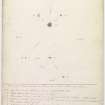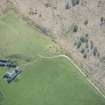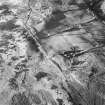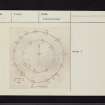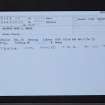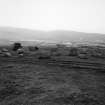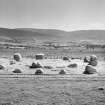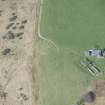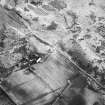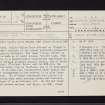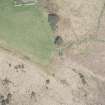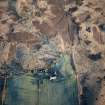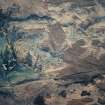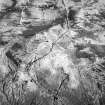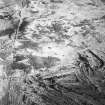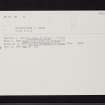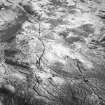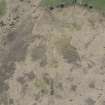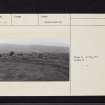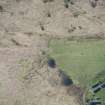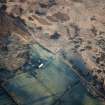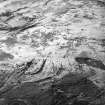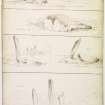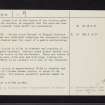Pricing Change
New pricing for orders of material from this site will come into place shortly. Charges for supply of digital images, digitisation on demand, prints and licensing will be altered.
Arran, Machrie Moor
Stone Circle(S) (Neolithic) - (Bronze Age)
Site Name Arran, Machrie Moor
Classification Stone Circle(S) (Neolithic) - (Bronze Age)
Alternative Name(s) Suidhe Coire Fhionn; Machrie Moor 5; Fingal's Cauldron Seat
Canmore ID 39705
Site Number NR93SW 10
NGR NR 90878 32353
Datum OSGB36 - NGR
Permalink http://canmore.org.uk/site/39705
- Council North Ayrshire
- Parish Kilmory
- Former Region Strathclyde
- Former District Cunninghame
- Former County Buteshire
Desk Based Assessment (28 June 1977)
NR93SW 10 90878 32353
See also NR93SW 1, 3 and 11.
(NR 9087 3234) Suidhe Coire Fhionn (NR)
(Stone Circle) (NR)
OS 6" map, Buteshire (1924)
This structure, called 'Suidh Coire Fhionn' or 'Fingal's Cauldron Seat' consists of two almost perfectly preserved rings of granite boulders. The inner circle, 37.9ft in diameter, is made up of eight stones, 3ft-4ft high. The outer circle is a geometrically constructed egg-shape; it consists of fifteen slightly smaller stones, one of which is perforated. M'Arthur, Bryce, and the ONB give the number in the outer ring as fourteen, and it is noticeable that stone 13 on plan spoils the symmetrical arrangement of the others; it is also lower than they are. As M'Arthur excavated this circle (in 1858), removing many small packing stones and boulders, possibly stone 13 is an intruder (2). He did not reach the original ground surface, but Bryce, in 1861, found an empty, ruined cist in the centre of the circles,under 1ft from the surface; he suggests that the area had been disturbed several times before his excavation.
Information from OS (IF) 28 June 1977.
Sources: A Roy, N McGrail and R Carmichael 1963; J McArther 1859; 1873; J Bryce 1863; Name Book 1864; E W MacKie 1975.
Field Visit (4 October 1977)
NR 9088 3235. 'Suidhe Coire Fhionn' or 'Fingal's Cauldron Seat' (name not confirmed) comprises two concentric stone circles situated near the crest of a gentle north-facing slope.
The inner circle is 12.0m in diameter and consists of eight granite boulders. Another stone almost buried lies outside the circle in the north-west. There are traces of an earthen ruin, 0.4m wide and 0.2m high, linking the stones. There is no evidence of a cist in the disturbed interior.
The outer circle is approximately 18.0m in diameter and is formed of fifteen stones similar to those of the inner circle. Its precise geometric pattern cannot be ascertained.
Surveyed at 1:10 000.
Visited by OS (T R G) 4 October 1977.
Publication Account (1985)
The area immediately around the abandoned steading at Moss Farm contains Scotland's most remarkable concentration of neolithic and bronze-age monuments. Included within this group are chambered cairns, round cairns, stone circles, standing stones, and hut-circles and field-systems. Only the plincipal monuments which are in state care are discussed in detail below, and for the convenience of the visitor the monuments are described from west to east in the order in which they will be encountered if approached from the track to Moss Farm.
1 Cairn (Moss Fann Road)
The track to Moss Farm clips the north side of the sadly mutilated remains of this large round cairn (probably of bronze-age date). It measures about 19m in diameter and is surrounded by an impressive boulder kerb which, in the past, has led to its erroneous descliption as a stone circle. The form and size of the cairn are comparable with those of Auchagallon (no. 95) and the two monuments are probably closely related. A slit trench which crosses the site is the poorly back-filled remains of a recent excavation.
2 Chambered Cairn
About 110m south-east of the first gate east of the Moss Farm Road cairn, there are the wasted remains of a chambered cairn which is straddled by the track. Its position is indicated by a lone tree and all that survives are parts of the chamber, lying between the track and the fence, and traces of the mound on the north side of the track.
3 Stone Circle
This unusual stone circle consists of two concentric Iings of stones; the outer is slightly egg-shaped and measures about 18m in maximum diameter, while the inner ring is circular measuting 11.5m in diameter. The stones of both rings are small rounded boulders and contrast with the impressive slabs seen elsewhere in the complex. Although this site is normally described as a double stone circle, it is not clear if the outerling was designed as a free-standing setting or was intended to be a kerb to the platform on which the inner circle rests. In the 19th century a cist was discovered in the inner circle.
4 Stone Circle
This small circle now complises four low granite boulders and it is not known whether there may oliginally have been more. Excavation in 1861 revealed a central cist containing a Food Vessel, a bronze pin or awl, and a group of flints. The finds are in the National Museum of Antiquities of Scotland, Edinburgh.
5 Stone Circle
Only four of the oliginal total of nine stones of this circle can now be seen and of these three have been reduced to stumps which barely project above the level of the peat. Excavation in 1861 revealed a central cist with a second lying a little to the south. In the latter there was a crouched inhumation accompanied by two flint flakes.
6 Stone Circle
This is the most spectacular of the Moss Farm stone circles with the three surviving uptights standing to a maximum height of up to 5.5m, making them amongst the tallest standing stones, in Scotland. The circle originally consisted of seven or eight stones, and the remains of some of the fallen monoliths litter the surrounding ground. In the more recent past an attempt has been made to reuse one of the fallen stones by converting it to the two halves of a set of mill stones, but the project was abandoned when the upper half broke in two. In 1861 two cists were found in the circle; one contained a Food Vessel with a cremation, and in the second there was a crouched inhumation.
7 Stone Circle
Although several of the stones of this circle (strictly speaking an ellipse) appear to be missing or displaced, it probably originally consisted of a ring of twelve stones arranged in an unusual manner with tall sandstone slabs alternating with squat granite boulders. This is the only circle in the Moss Fann group to have this feature which, in fact, is rarely seen in Scotland as a whole.
8 Stone Circle
The preceding stone circles at Moss Farm have all been known since the mid-19th century, but this final circle was only identified recently when attention was drawn to a number of stones projecting through the peat. On excavation they proved to be part of a circle of ten stones, which have subsequently been left exposed. Between the stones there were the post-holes of an earlier ring of timber uprights, indicating a rather more complex history than the surface traces might have suggested.
Information from ‘Exploring Scotland’s Heritage: The Clyde Estuary and Central Region’, (1985).
Watching Brief (14 April 1997 - 17 April 1997)
NR 908 323 A watching brief was maintained by Kirkdale Archaeology during the excavation of small trenches in the area of the Moss Farm stone circle. These works were intended to realign the fence protecting the monument within the confines of the guardianship area. Two holes 25cm wide and 75mm deep were dug into the subsoil 5m from the bank surrounding the stone circle. The same sequence of deposits was revealed in each trench; 15cm of peaty soil overlay 6cm of clean orange stony sand. There were no finds.
Sponsor: Historic Scotland
G Ewart and P Sharman 1997
Note (23 July 2018 - 24 July 2018)
The location, classification and period of this site have been reviewed.
HES Survey and Recording 23-24 July 2018.










































